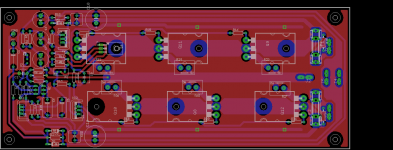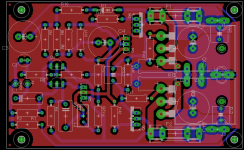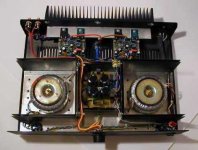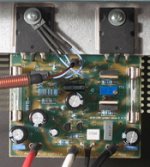I did on an earlier iteration, can't remember why I changed them to top mount. It was probably a very good reason... 😀
Another diversion from the BigA, just realised it's getting near Christmas, and I promised my nieces sound systems for pressies. Youngest is easy, a desktop system with chipamps, but the older wants a bigger system for her student lodgings, so a basic Baby on 40V rails should do the trick. Now where did I put those Eagle files...
Ta. Will be fan cooled, as I want to build a nice compact amp, and I've found a traffo in the junk box with 20-0-12 and 27-0-27 so the preamp is sorted as well.
Here's a pic of the speakers, still to cut some metal grille for protection. Oh, and in the background, you can see the 15" monitors the BigA will be driving. 😉
Here's a pic of the speakers, still to cut some metal grille for protection. Oh, and in the background, you can see the 15" monitors the BigA will be driving. 😉
Attachments
Last edited:
A good way to test the Baby's beat. 😎
Just remember that I change some capacitor values (C1 and C2), see on post #618:
http://www.diyaudio.com/forums/solid-state/168554-based-hugh-deans-aksa-55-a-62.html#post2791110
Also, in this second run I initially noticed sound not very pleasant as expected... improved after warming (some musics) and then bias readjust.
Rgds.
Just remember that I change some capacitor values (C1 and C2), see on post #618:
http://www.diyaudio.com/forums/solid-state/168554-based-hugh-deans-aksa-55-a-62.html#post2791110
Also, in this second run I initially noticed sound not very pleasant as expected... improved after warming (some musics) and then bias readjust.
Rgds.
Last edited:
Yeah, this one is just a test item to check for bugs, work out the mechanical layout and play with components. Once finalised, I'll build the production versions for Ellie.
Hi,I did a search on google and I found that in earlier Aksa the drivers were not mounted on the heatsink. The drivers were located behind the power outputs on the pcb.
Is there any performance difference between that Aksa and the present with the drivers mounted on the main heatsink?
Is there any performance difference between that Aksa and the present with the drivers mounted on the main heatsink?
Attachments
Hi,I did a search on google and I found that in earlier Aksa the drivers were not mounted on the heatsink. The drivers were located behind the power outputs on the pcb.
Is there any performance difference between that Aksa and the present with the drivers mounted on the main heatsink?
Hi xeclipse,
I have 2 versions of the AKSA 55, one on with the drivers on the heatsink and one without. I don't reckon there is much difference in normal operationing conditions. Both have been 100% reliable after many years work.
regards
Hello Greg,thanks for the reply and for the input in this thread.
It happened that I came across a pcb layout of an Aksa amp (I won't be posting it here).The drivers are behind the outputs on the pcb and it uses no thermal tracking vbe multiplier transistor (just two diodes for biasing). Did Hugh produce this amplifier commercially? I haven't seen any picture of it.
Regards.
It happened that I came across a pcb layout of an Aksa amp (I won't be posting it here).The drivers are behind the outputs on the pcb and it uses no thermal tracking vbe multiplier transistor (just two diodes for biasing). Did Hugh produce this amplifier commercially? I haven't seen any picture of it.
Regards.
two series diodes (~1200mV) as the bias voltage for a two stage EF+EF output does not sound like ClassAB and therefore is unlikely to be an Aksa audio product
With a 100R port in series.two series diodes
Its actually a photo an empty pcb with the components and values printed.Copper tracks are visible through the pcb. With that I can easily draw the layout using ExpressPcb........therefore is unlikely to be an Aksa audio product
Hello Greg,thanks for the reply and for the input in this thread.
It happened that I came across a pcb layout of an Aksa amp (I won't be posting it here).The drivers are behind the outputs on the pcb and it uses no thermal tracking vbe multiplier transistor (just two diodes for biasing). Did Hugh produce this amplifier commercially? I haven't seen any picture of it.
Regards.
Hi xeclipse,
There was an early version of the AKSA 55 available through Elliott Sound Products, the P61 75 watts. This sounds like the one you are describing. I don't think it was commercially available in that format.
Regards
Member
Joined 2009
Paid Member
diode biassing can actually be superior - I've seen people report a preference for it. I think it's less sensitive to changes in VAS current.
Xeclipse,
No discernible difference in thermal stability between drivers on pcb and drivers on heatsink. Odd, but there it is..... I think the reason is that the drivers operate at a much more consistent temperature than the outputs.
Early AKSAs did in fact use two 1N4148 diodes and a small 100R pot, diodes thermally contacting the heatsink, for bias generator. It worked extremely well as Bigun suggested, and in fact I believe the diodes sound a bit better than the usual Vbe multiplier, which I moved to down the track.
All the AKSAs were produced commercially as kitsets for about six years from 2000. Three versions were offered; stock, Nirvana and Nirvana Plus with Black Gates and all the fancy audiophile components. It was a very popular amp and still has its devotees.
Later I designed the Lifeforce, then the Soraya, and after having no life for almost six years with all the emails, decided to move to module products, with the amp ready built and tested and simply requiring hook up to a power supply. That business model is not quite as fast moving, since prices are higher, but it gives me back my life and ensures close quality control. I've since improved the sonics over the original AKSA - no contest at all - and the latest New AKSA, the NAKSA - is an exquisite sounding amplifier.
Thank you for your interest,
Hugh
No discernible difference in thermal stability between drivers on pcb and drivers on heatsink. Odd, but there it is..... I think the reason is that the drivers operate at a much more consistent temperature than the outputs.
Early AKSAs did in fact use two 1N4148 diodes and a small 100R pot, diodes thermally contacting the heatsink, for bias generator. It worked extremely well as Bigun suggested, and in fact I believe the diodes sound a bit better than the usual Vbe multiplier, which I moved to down the track.
All the AKSAs were produced commercially as kitsets for about six years from 2000. Three versions were offered; stock, Nirvana and Nirvana Plus with Black Gates and all the fancy audiophile components. It was a very popular amp and still has its devotees.
Later I designed the Lifeforce, then the Soraya, and after having no life for almost six years with all the emails, decided to move to module products, with the amp ready built and tested and simply requiring hook up to a power supply. That business model is not quite as fast moving, since prices are higher, but it gives me back my life and ensures close quality control. I've since improved the sonics over the original AKSA - no contest at all - and the latest New AKSA, the NAKSA - is an exquisite sounding amplifier.
Thank you for your interest,
Hugh
- Home
- Amplifiers
- Solid State
- Based on Hugh Dean's AKSA 55





